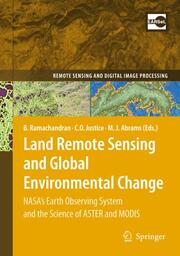-
Zusatztext
-
InhaltsangabePrologue.- Acknowledgements.- Part I: The Earth Observing System and the Evolution of ASTER and MODIS.- Evolution of NASA's Earth Observing System (EOS) and Development of the Moderate-resolution Imaging Spectroradiometer (MODIS) and the Advanced Spaceborne Thermal Emission and Reflection Radiometer (ASTER) Instruments.- Philosophy and Architecture of the EOS Data and Information System (EOSDIS).- Lessons Learned from the EOSDIS Engineering Experience.- Part II: ASTER and MODIS: Instrument Design, Radiometry and Geometry.- Terra ASTER Instrument Design and Geometry.- ASTER VNIR and SWIR Radiometric Calibration and Atmospheric Correction.- ASTER TIR Radiometric Calibration and Atmospheric Correction.- Terra and Aqua MODIS Design, Radiometry and Geometry in Support of Land Remote Sensing.- Part III: ASTER and MODIS: Data Systems.- ASTER and MODIS Land Data Management at the Land Processes and National Snow and Ice Data Centers.- An Overview of the EOS Data Distribution Systems.- The Language of EOS Data: Hierarchical Data Format.- Part IV: ASTER Science and Applications.- The ASTER Data System: An Overview of the Data Products in Japan and US.- ASTER Applications in Volcanology.- Issues affecting geological mapping with ASTER Data: A Case Study of the Mt Fitton Area, South Australia.- ASTER Data Use in Mining Applications.- ASTER Imaging and Analysis of Glacier Hazards.- ASTER Application in Urban Heat Balance Analysis: A Case Study of Nagoya.- Monitoring Urban Change with ASTER Data.- Estimation of methane emission from west Siberian lowland with sub-pixel land cover characterization between MODIS and ASTER.- ASTER Stereoscopic Data and Digital Elevation Models.- Using ASTER Stereo Images to Quantify Surface Roughness.- Technoscientific Diplomacy: The Practice of International Politics in the ASTER Collaboration.- Part V: MODIS Science and Applications.- MODIS Land Data Products: Generation, Quality Assurance and Validation.- MODIS Directional Surface Reflectance Product: Method, Error Estimates and Validation.- Aqua and Terra MODIS Albedo and Reflectance Anisotropy Products.- MODIS Land Surface Temperature and Emissivity.- MODIS Vegetation Indices.- Leaf Area Index and Fraction of Absorbed PAR Products from Terra and Aqua MODIS Sensors: Analysis, Validation and Refinement.- MODIS-Derived Terrestrial Primary Production.- MODIS-Derived Global Fire Products.- MODIS Snow and Ice Products, and their Assessment and Applications.- Characterizing Global Land Cover Type and Seasonal Land Cover Dynamics at Moderate Spatial Resolution Using MODIS.- MODIS Vegetative Cover Conversion and Vegetation Continuous Fields.- Multi-Sensor Global Retrievals of Evapotranspiration for Climate Studies Using the Surface Energy Budget System.- Part VI: The Future of Land Remote Sensing.- The Evolution of U.S. Moderate Resolution Optical Land Remote Sensing from AVHRR to VIIRS.- The Future of Landsat-Class Remote Sensing.- International Coordination of Satellite Land Observations: Integrated Observations of the Land.- Index.
-
-
Kurztext
-
Global environmental change remains a constant theme that resonates worldwide. The dynamics of the Earth system fosters complex spatio-temporal variations that highlight the significance of, and the need to monitor the Earth as a unified whole. Accurate, timely, and reliable data are a precursor to analyze and study several aspects of the integrated Earth system. Remote sensing observations have catalyzed several aspects of Earth system science by providing panoptic views and time-series measurements of the study environment in ways nearly impossible to replicate by traditional ground-based methods. NASA's Earth Observing System's (EOS) primary goal is to study and understand all interacting components of the Earth as a dynamic system. Land Remote Sensing and Global Environmental Change is an edited compendium that specifically focuses on the terrestrial components of change based on the scientific knowledge derived from data produced by two EOS instruments, ASTER and MODIS, which are part of the Terra and Aqua satellite missions. As global environmental change in the Anthropocene age becomes more ubiquitous, the papers presented in this volume demonstrate the value of EOS for studying the Earth's surface. This volume helps articulate the EOS mission as a rich synergistic confluence of science, engineering, and technology, which helps us decipher how our terrestrial systems both contribute and respond to global environmental change.Audience: The primary audience for this book includes Earth and environmental science researchers and professionals, including those who use land remote sensing data.
-
-
Autorenportrait
- Bhaskar Ramachandran is a senior scientist who supports the NASA Earth Observing System (EOS) science mission at the Earth Resources and Observation Science (EROS) Center at the U.S. Geological Survey in Sioux Falls, South Dakota. He currently supports the MODIS science mission, and has performed similar roles for the Landsat-7 and ASTER missions in the past. His current research interests include the use of semantic web capabilities, and building ontologies to represent geospatial science knowledge domains. Chris Justice is a Professor and Research Director at the Geography Department of the University of Maryland. He is the land discipline chair for the NASA MODIS Science Team and is responsible for the MODIS Fire Product. He is a member of the NASA NPOESS Preparatory Project (NPP) Science Team. He is the NASA Land Cover Land Use Change Program Scientist. His current research is on land cover and land use change, the extent and impacts of global fire, global agricultural monitoring, and their associated information technology and decision support systems. Michael Abrams received his degrees in Biology and Geology from the California Institute of Technology. Since 1973 he has worked at NASA's Jet Propulsion Laboratory in geologic remote sensing. He served on the science team for many instruments, including Skylab, HCMM, Landsat, and EO-1. Areas of specialization are mineral exploration, natural hazards, volcanology, and instrument validation. He has been on the US/Japan ASTER Science Team since 1988, and became the ASTER Science Team Leader in 2003.
Detailansicht
Land Remote Sensing and Global Environmental Change
NASA's Earth Observing System and the Science of ASTER and MODIS, Remote Sensing and Digital Image Processing 11
ISBN/EAN: 9781441967480
Umbreit-Nr.: 1925824
Sprache:
Englisch
Umfang: xlii, 873 S.
Format in cm:
Einband:
gebundenes Buch
Erschienen am 08.11.2010
Auflage: 1/2010


